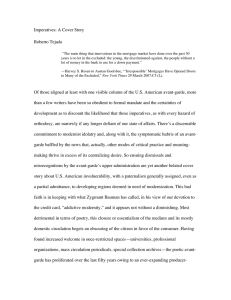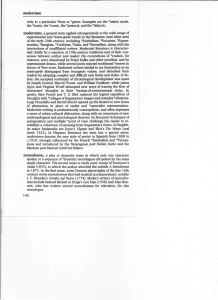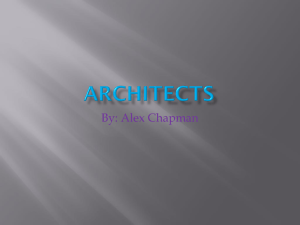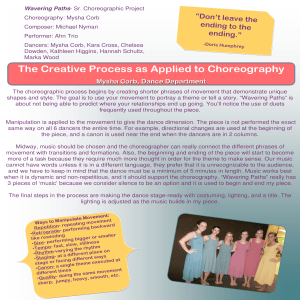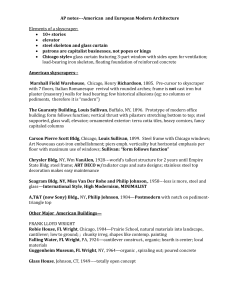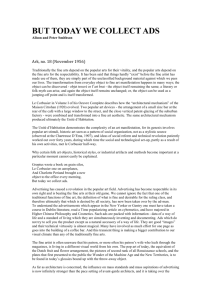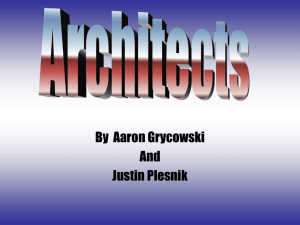8-2. What aspects of the old, "modernist" avant-garde are retained,... work of the so-called "post-modern" or "deconstructivist" architects (The New...
advertisement
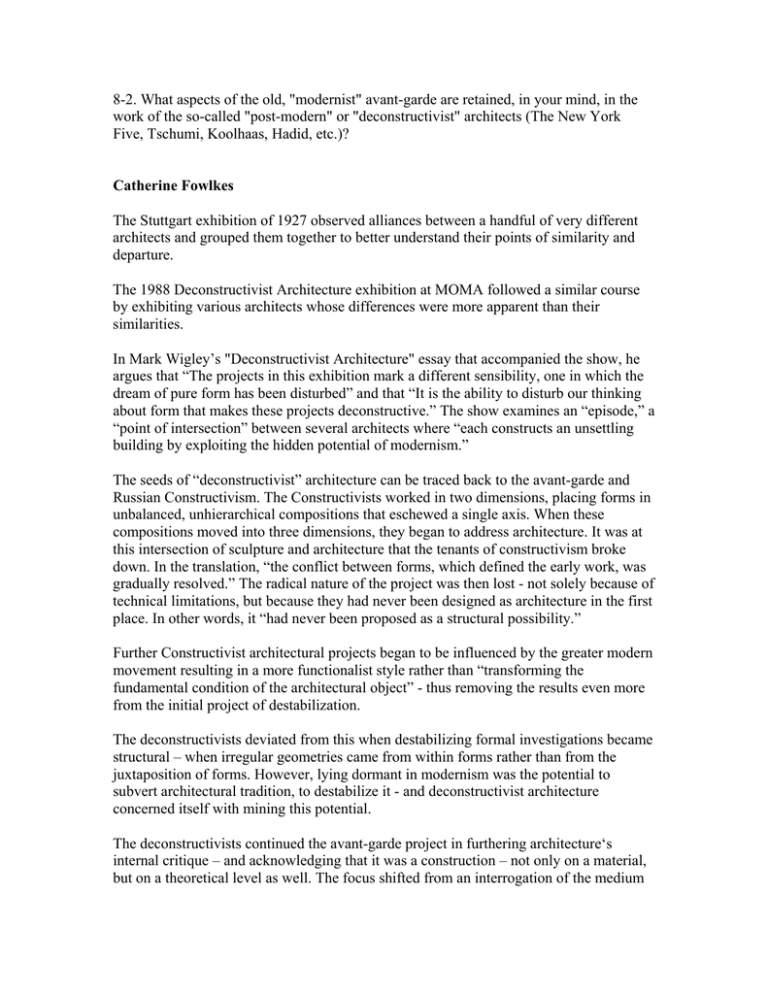
8-2. What aspects of the old, "modernist" avant-garde are retained, in your mind, in the work of the so-called "post-modern" or "deconstructivist" architects (The New York Five, Tschumi, Koolhaas, Hadid, etc.)? Catherine Fowlkes The Stuttgart exhibition of 1927 observed alliances between a handful of very different architects and grouped them together to better understand their points of similarity and departure. The 1988 Deconstructivist Architecture exhibition at MOMA followed a similar course by exhibiting various architects whose differences were more apparent than their similarities. In Mark Wigley’s "Deconstructivist Architecture" essay that accompanied the show, he argues that “The projects in this exhibition mark a different sensibility, one in which the dream of pure form has been disturbed” and that “It is the ability to disturb our thinking about form that makes these projects deconstructive.” The show examines an “episode,” a “point of intersection” between several architects where “each constructs an unsettling building by exploiting the hidden potential of modernism.” The seeds of “deconstructivist” architecture can be traced back to the avant-garde and Russian Constructivism. The Constructivists worked in two dimensions, placing forms in unbalanced, unhierarchical compositions that eschewed a single axis. When these compositions moved into three dimensions, they began to address architecture. It was at this intersection of sculpture and architecture that the tenants of constructivism broke down. In the translation, “the conflict between forms, which defined the early work, was gradually resolved.” The radical nature of the project was then lost - not solely because of technical limitations, but because they had never been designed as architecture in the first place. In other words, it “had never been proposed as a structural possibility.” Further Constructivist architectural projects began to be influenced by the greater modern movement resulting in a more functionalist style rather than “transforming the fundamental condition of the architectural object” - thus removing the results even more from the initial project of destabilization. The deconstructivists deviated from this when destabilizing formal investigations became structural – when irregular geometries came from within forms rather than from the juxtaposition of forms. However, lying dormant in modernism was the potential to subvert architectural tradition, to destabilize it - and deconstructivist architecture concerned itself with mining this potential. The deconstructivists continued the avant-garde project in furthering architecture‘s internal critique – and acknowledging that it was a construction – not only on a material, but on a theoretical level as well. The focus shifted from an interrogation of the medium itself to one about performance and effect. - “Decontructivist Architecture,” Mark Wigley from Deconstructivist Architecture, Mark Wigley and Phillip Johnson, 1988. Operative Criticism: Manufacturing the Modern Robert Campos The presence of an “operative criticism” (Tafuri in Colomina, 34, n. 36) as embodied by specific figures—architects, critics, historians—is significant in the development of both the “old, ‘modernist’ avant-garde” (and here we should consider the differences between the two terms, also as outlined by Colomina) and the more recent trends of “Po-Mo”, “Decon” and the like. Tafuri defines “operative criticism” as: an analysis of architecture…that has at its objective the planning of a precise poetical tendency, anticipated in its structure and derived from historical analyses programmatically distorted and finalized. (Theories and History of Architecture, 141) In his introduction to Building in France…, Georgiadis makes clear the construction of an “anticipated poetical tendency” in the seminal modernist history. The iron structures of the 19th century and the new ferroconcrete buildings of Giedion’s day are connected precisely by an elision—of the "problem of corporeality” that predominated discourse from Botticher in 1846 onward (42). Georgiadis contends that one only is able to “neutralize” the “basic incompatibility and aesthetic incommensurability” of the two productions by assuming “the perspective of the observer”—"precisely what Giedion does" (42). Furthermore, it is armed with the “visual apparatus of modern man—formed and educated…through the study of Cubism and Neoplasticism”—Corbusier’s territory, not incidentally—that Giedion “wanders through his objects in a cinematographic [i.e. non-corporeal] fashion” (43). As a self-proclaimed writer of “propaganda”, Giedion was sensitive to the role which visual design played in his book’s impact, and took great care in selecting and laying out his images and captions. Perhaps the only figure more sensitive to this issue than Giedion is Corb himself, who in the design of L’Esprit Nouveau employed the “never-resolved collisions” of juxtaposed image and text to frame the terms of his arguments (Colomina 60). It is a technique which Colomina equates with advertising (63). In his (modern? avant-garde?) magazine, Corbusier continuously employed the image of the machine to construct a conceptual “machine age”—a fiction which would serve his own agenda in much the same way that Giedion’s text constructs a line between two “incompatible aesthetics”: The very idea of the ‘machine age’… served the period as a symbolic concept, doubtless to say largely induced by the advertising industry…[T]he concept of the ‘machine age’ has served the purpose of sustaining the myth of the ‘modern movement’ as an autonomous artistic practice and of the architect as ‘interpreter’ of the new industrial reality. (Colomina 67) Relying on his sophisticated understanding of the power of the mass media (specifically, print) for maximum impact, Corb constructs his own narrative of “poetical tendency”, and as Giedion through an elision (or more precisely, perhaps, a nondisclosure). That his, as with the example of the Maison Pirsoul bidet, Corb invests industrial products—L’art decoratif moderne—“not with the individual character of artistic creation but the anonymous one of industrial production, of folklore” (Colomina 76). But the facts belie this fiction: far from “anonymous”, products like the Pirsoul bidet were, and continue to be, by all accounts a form of intellectual property, “belonging” if not to an individual author/artist than to a corporation. As Giedion and Corb (and Barr, Johnson, and Russell-Hitchcock) were to the Modern Movement, Rowe and Frampton (the New York Five) and Wigley (Deconstruction) have been to the “post-modern”. The latter three have constructed their own “poetical tendencies” within modernism and its discontents to establish an imagined line between past and present (e.g. the precursors of Constructivism/Suprematism), and present and present (e.g. the lumping together of the likes of Gehry and Koolhaas, or of literary criticism with architecture). And speaking of The Rem, in light of Giedion’s and MoholyNagy’s collaboration on Building in France, and Corb’s welcome “corporate sponsorship” doubling as editorial content in L’Esprit Nouveau, such efforts as Delirious New York (subtitled, quite tellingly, “A Retroacive Manifesto”), S,M,L,XL (with designer Bruce Mau's name on the cover) and Content with its ads and pop-culture iconography can be seen less as radically new emergences within architectural discourse and more as the “reclaiming” of a certain territory originally staked out it in the earlier decades of the 20th century by such figures of Benjaminian “radical knowledge" as Giedion—and the attempt to assume the mantle of the "truly" avant-garde as Corbusier, in Colomina's analysis, failed to do.
